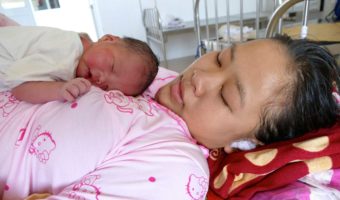Shenzhen has developed rapidly in the last four decades, from a small fishing village to an international metropolis with GDP totalling 2.25 trillion yuan (256 billion euros) and a population over 12.5 million. But, in the process, children’s needs have been overlooked. The only spaces many children have to play in are on the edge of busy roads, in the shadow of high-rise buildings. The municipal government has now committed to improve the city for its youngest residents: in 2016 it formally proposed to make Shenzhen a child-friendly city.
Ambitions on social protection, child participation and development of urban spaces were outlined in Shenzhen’s latest five-year plan – a local adaptation of the objectives outlined in China’s national five-year plan. A provincial committee with a working group headed by the Deputy Mayor was put in charge of coordinating plans for creating a child-friendly city, and involving city departments such as Housing and Construction, the Environment, Planning and Land Resources, and Traffic and Transportation. The committee issued the Shenzhen Children-Friendly City Strategic Plan (2018–2035) and Shenzhen Child-Friendly City Action Plan (2018–2020), the first such local programmatic documents in China.
In consultation with specialists, the Shenzhen city government developed guidelines and standards for child-friendly hospitals, libraries, parks, schools, etc., to address children’s needs in areas such as education, leisure, nature and the environment.
Shenzhen is building 200 km of walking trails and improving its cycling system to create a pedestrian-friendly, cycling-friendly transportation environment. Shenzhen has built 265 km of subway lines, and tickets for young children are free or half-price. Its bus fleet is now 100% electric, contributing to improving air quality, a particularly important issue for very young children.
The city government has recognised the need to involve the private sector, non-governmental organisations and citizens in its efforts to make the city more child-friendly. At the Shenzhen Women and Children’s Development Foundation, we have a two-track strategy to our involvement. First, a top-down approach – we are helping the government to promote its initiatives and develop policy papers. Second, a bottom-up approach – we are working with the government and other partners to carry out innovative pilot projects.
Promoting breastfeeding facilities
One example relevant to the very youngest residents of Shenzhen is our involvement since 2016 in work to encourage the provision of breastfeeding facilities and increase rates of breastfeeding. This has included gathering data from citizens about what facilities already existed, and constructing demonstration mother-and-baby rooms in a wide variety of public places, to show that breastfeeding should be possible anywhere – from shopping malls to metro stations, from parks to hospitals.
We held a series of competitions to engage the public in submitting design ideas for mother-and-baby rooms and for breastfeeding covers – shawls that mothers can choose to wear when they want to breastfeed and are not near a facility offering privacy. In parallel, we are conducting communications campaigns to increase the acceptability of breastfeeding in public places.
With the joint efforts of academics and our foundation, the city government has published construction guidelines and standards for mother-and-baby rooms, and has offered supervision and training for personnel in charge of them. We successfully advocated for breastfeeding facilities to be included in public policies related to making Shenzhen more child-friendly. In December 2018, working with the government, we launched an app through which families can find their nearest breastfeeding-friendly facility.
Dozens of private sector and social organisations have joined this work. At the time of writing, there are over 460 mother-and-baby rooms across Shenzhen, and the government has committed to increase the number to a thousand by 2020. Promotion of breastfeeding is part of our wider push to raise awareness of healthy feeding practices and early childhood development, with other activities including distribution of bags with reading materials for toddlers.
Early childhood education and play
‘The city government has published construction guidelines and standards for mother- and-baby rooms, and training for personnel.’
The Shenzhen government is committed to tackling the shortage of resources and equalising early childhood educational opportunities for all children by investing in the construction and upgrading of inclusive kindergartens, encouraging more college students to major in preschool education, and developing dietary management and nutrition standards for kindergartens.
At present, there are 1771 kindergartens in Shenzhen. The number of enrolled children has reached 524,200, ranking first in China. To assure equal access to public education for children with disabilities, Shenzhen has been improving the number of special education schools and classes, forming teams of special teachers to develop integrated education, and increasing the enrolment rate of children with disabilities.
A child-friendly city includes creating opportunities for play and interaction. Together with the Shekou Community Foundation, and after coordination with various traffic departments, we held a ‘car-free day’ activity in Shekou, an area of Shenzhen. In September 2018, a major thoroughfare was closed to traffic and activities were held including street carnivals, creative bazaars and street gardens.
Shenzhen is known for being ‘the city of thousands of gardens’, with a forest coverage rate of 41.2% and parks where families can get close to nature – which is greatly beneficial to the early development of children. All municipal parks are open to the public free of charge and some have separate play spaces for children of different age groups: 0–3, 3–6, 6–12 and 12–18. The Action Plan provides special funds for natural education and training, and regular ‘outdoor nature practice’ courses in primary and secondary schools. Shenzhen has built nearly 20 natural education bases, and the number is expected to reach 100 in the next two years.
A model for other cities
Creating child-friendly cities is a recent initiative in China. The experience in Shenzhen has already generated valuable knowledge and practices, and shown how civil society can play an important role in advocating with local government, raising public awareness, implementing policies, and so on. However, every city is different and tools will need to be adapted accordingly through a participatory approach also involving academia, the private sector, and families and children themselves.
We see the Shenzhen Women and Children’s Development Foundation playing the role of both a bridge and a hub. In terms of bridging, we are facilitating communication and exchange between the Shenzhen city government’s child- friendly city working group and international initiatives; in our role as a hub, we have been conducting research locally to develop indicators on child- friendliness which government agencies and social organisations can use as a reference. We anticipate being able to learn from our experiences in Shenzhen and provide support to other cities in future.
References can be found in the PDF version of the article.



